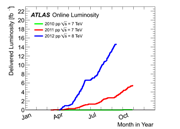 LHC - Higgs factory
LHC - Higgs factory
by Mike Lamont (CERN)


Fig1: Joe Incandela, CMS Spokesperson presenting at Higgs search update on 4 July 2012. (click to enlarge) Image credit: CERN
Fig2: Improvements in LHC performance are clear - this graph shows the luminosity delivered to the Atlas experiment in 2010 (green), 2011 (red) and 2012 (blue) for proton-proton collisions. Image credit: CERN
With a wry smile, Fabiola Gianotti showed the significance of the combined gamma-gamma and 4 lepton channels. "We observe in our data clear signs of a new particle, at the level of 5 sigma, in the mass region around 126 GeV." She gave heartfelt thanks to "the whole LHC exploitation team, including the operation, technical and infrastructure groups, for the outstanding performance of the machine, and to all the people who have contributed to the conception, design, construction and operation of this superb instrument".
It hasn't been easy. First beams were injected on the 10th September 2008. 9 days later - disaster, and it was November 2009 before beams were injected again following a Herculean effort to repair the seriously damaged sector 34. The causes of the incident were examined closely and caution dictated running at less than design energy: 3.5 TeV in 2010 and 2011; 4 TeV in 2012.
2010 was devoted to commissioning with beam with a very careful eye on the critical machine protection system. Towards the end of the year luminosity production really started. The total for 2010: around 50 inverse picobarns. The total by the 4th July 2012: around 10,000 inverse picobarns.
The machine has a limited number of parameters it can use to increase the collision rates seen by the experiments: number of bunches; number of protons per bunch; and the beam size at the interaction point. Over the last couple of years the LHC and its injectors have pushed hard on all options with considerable reward. Squeezing the beam sizes down to around 70 microns at the interaction points in ATLAS and CMS, coupled with small beam sizes and high bunch intensities from the injector chain have resulted in truly impressive collision rates. This performance, together with good machine availability, has allowed the LHC to deliver something like 800 trillion collisions to each of ATLAS and CMS. A very few of these have produced something that looks like a Higgs.
Read more >>